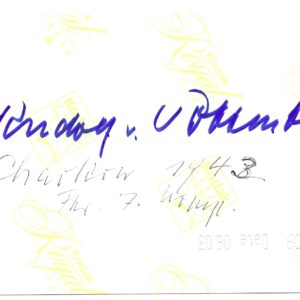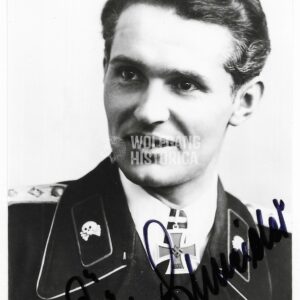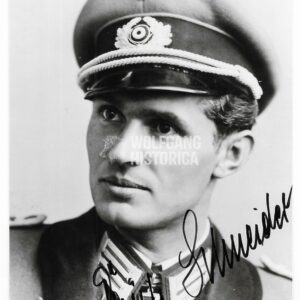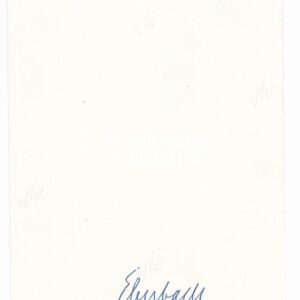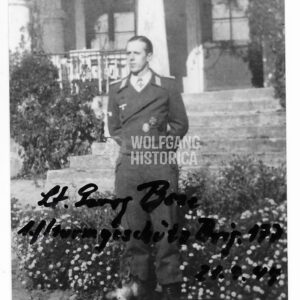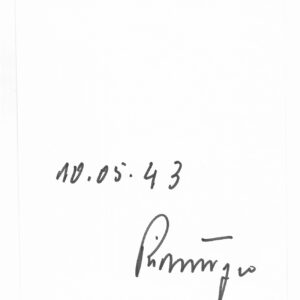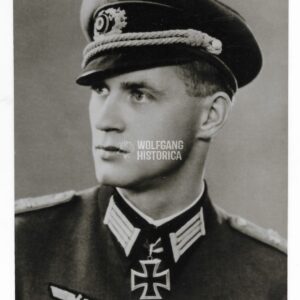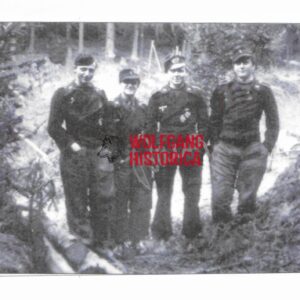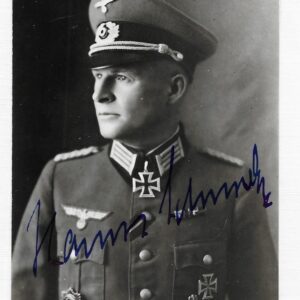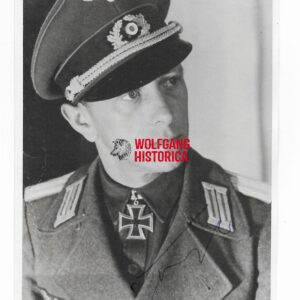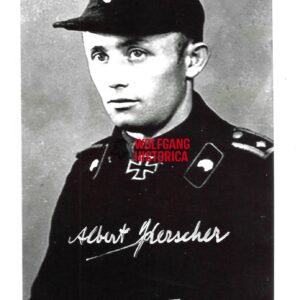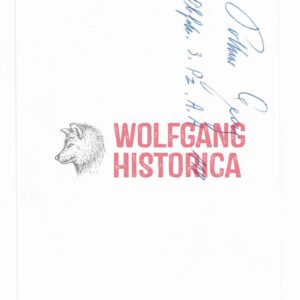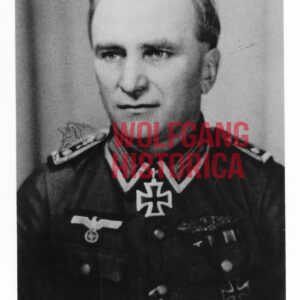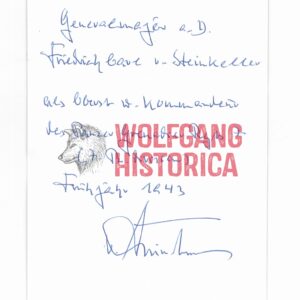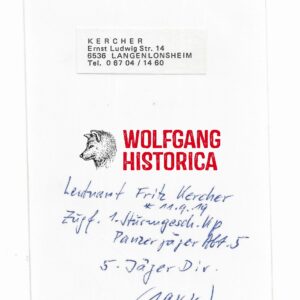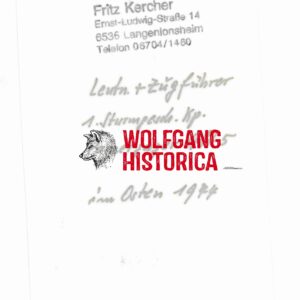Karl Brommann – schwere SS-Panzer-Abteilung 503 (King Tiger & Battle of Berlin!)
€55,00Hellmut von Leipzig – Panzer-Aufklärungs-Abteilung “Brandenburg” & Driver of Erwin Rommel !
€25,00Hellmut von Leipzig – Panzer-Aufklärungs-Abteilung “Brandenburg” & Driver of Erwin Rommel !
€25,00Rudolf von Ribbentrop – SS-Panzer-Regiment 1 “LSSAH” & 12 “Hitlerjugend” (Kharkov, Kursk, Normandy & Ardennes!)
€55,00Rudolf von Ribbentrop – SS-Panzer-Regiment 1 “LSSAH” & 12 “Hitlerjugend” (Kharkov, Kursk, Normandy & Ardennes!)
€55,00Johann Sailer – SS-Panzerjäger-Abteilung 9 “Hohenstaufen”
€40,00Karl Nicolussi-Leck – SS-Panzer-Regiment 5 “Wiking”
€55,00Wolfgang Wahl – Panzer-Regiment 8 (Afrika)
€80,00Bruno Kahl – Panzer-Regiment 21 & Panzerjäger-Regiment 656 (Eichenlaub)
€30,00Rudolf von Ribbentrop – SS-Panzer-Regiment 1 “LSSAH” & 12 “Hitlerjugend”
€55,00Rudolf von Ribbentrop – SS-Panzer-Regiment 1 “LSSAH” & 12 “Hitlerjugend”
€55,00Rudolf von Ribbentrop – SS-Panzer-Regiment 1 “LSSAH” & 12 “Hitlerjugend”
€55,00Engelbert Bockhoff – Panzer-Aufklärungs-Abteilung 9 (9. Panzer-Division)
€30,00Gerhard Beier – Panzerjäger-Kompanie 1193 (93. Infanterie-Division)
€20,00Wolf-Horst Hoppe – schwere Panzerjäger-Abteilung 519
€30,00Karl Gerlach – Panzer-Regiment 35 (4. Panzer-Division)
€30,00Erich Schneider – Panzer-Regiment 9 (25. Panzer-Division)
€25,00Erich Schneider – Panzer-Regiment 9 (25. Panzer-Division)
€25,00Heinrich Eberbach – Panzer-Regiment 35 & Panzer-Brigade 5 (Eichenlaub)
€45,00Original Postwar Signature on a Postwar Photo of Heinrich Eberbach. General der Panzertruppen Heinrich Eberbach (24.11.1895 in Laufen am Neckar † 13.07.1992 in Notzingen) earned the Ritterkreuz des Eisernen Kreuzes on July 4, 1940 as Oberstleutnant und Kommandeur of the Panzer-Regiment 35 and the Eichenlaub on December 31, 1941 as Oberst und Kommandeur of the 5. Panzer-Brigade.
Provenance: This signature comes from one of the largest postwar signature collection I’ve ever commissioned. This collection was started by a Waffen-SS Veteran, Werner H., in the 1950’s until he passed away.
Georg Bose – Sturmgeschütz-Abteilung 177
€25,00Original Postwar Signature on a Postwar Photo of Georg Bose. Leutnant Georg Bose (20.10.1921 † 26.09.2011) earned the Ritterkreuz des Eisernen Kreuzes on September 21, 1944 as Leutnant und Zugführer of 1. Kompanie/ Sturmgeschütz-Abteilung 177.
Provenance: This signature comes from one of the largest postwar signature collection I’ve ever commissioned. This collection was started by a Waffen-SS Veteran, Werner H., in the 1950’s until he passed away.Konrad Zecherle – Panzer-Aufklärungs-Abteilung 90 (90. leichte Afrika-Division)
€25,00Friedrich Rass – Panzergrenadier-Regiment 11 (9. Panzer-Division)
€25,00Ludwig Bauer – Panzer-Regiment 33
€17,50Ludwig Bauer – Panzer-Regiment 33
€17,50Hugo Primozic – Sturmgeschütz-Abteilung 667 (Eichenlaub) (Wartime Signature)
€125,00Original Wartime Signature on a Wartime Postcard of Hugo Primozic. Oberleutnant Hugo Primozic (16.02.1914 † 18.03.1996) earned the Ritterkreuz on September 19, 1942 as Wachtmeister und Zugführer of the 2. Batterie/ Sturmgeschütz-Abteilung 667 and the Eichenlaub on January 25, 1943 as Oberwachtmeister und Zugführer of the 2. Batterie/ Sturmgeschütz-Abteilung 667. Good condition.
Ritterkreuz: “Awarded for destroying 45 enemy tanks during the fighting in the central sector of the Eastern front. Of these, Primozic destroyed 24 in just one day (15.09.1942) and in doing so was able to prevent an enemy breakthrough.” Eichenlaub: “Awarded for bringing his total of tanks destroyed to 60. During a counterattack on 11.12.1942 he destroyed 7 tanks in one day.”Johannes Schmidt – Panzer-Regiment 27 (19. Panzer-Division)
€22,50Original Postwar Signature on a Postwar Photo of Dipl.-Ing. Johannes Schmidt. Dipl.-Ing. Johannes Schmidt (30.09.1899 † 10.11.1987) earned the Deutsches Kreuz in Gold and Ritterkreuz on October 15, 1942 as Oberstleutnant and Kommandeur of the III. Abteilung/ Panzer-Regiment 27 of the 19. Panzer-Division.
Provenance: This signature comes from one of the largest postwar signature collection I’ve ever commissioned. This collection was started by a Waffen-SS Veteran, Werner H., in the 1950’s until he passed away.
Klaus Müller – Panzer-Abteilung 60
€25,00Hans Kochanowski – Sturmgeschütz-Abteilung 201
€30,00Bruno Kahl – Panzer-Regiment 21 & Panzerjäger-Regiment 656 (Eichenlaub)
€30,00Heinz Beutler – Panzer-Regiment 2
€20,00Albert Kerscher – schwere Panzer-Abteilung 502
€30,00Hermann Eckardt – Panzer-Abteilung 8
€25,00Heinz Kolczyk – Panzer-Aufklärungs-Abteilung 7 (7. Panzer-Division)
€20,00Original Postwar Signature on a Postwar Photo of Heinz Kolczyk. Rittmeister Heinz Kolczyk (20.11.1912 † 10.11.2008) earned the Ritterkreuz des Eisernen Kreuzes on April 6, 1944 as Rittmeister und Kommandeur of the Panzer-Aufklärungs-Abteilung 7 of the 7. Panzer-Division. Good condition. Size: 8×11,3cm.
Provenance: This signature comes from one of the largest postwar signature collection I’ve ever commissioned. This collection was started by a Waffen-SS Veteran, Werner H., in the 1950’s until he passed away.
Rudolf von Ribbentrop – SS-Panzer-Regiment 1 “LSSAH” & 12 “Hitlerjugend”
€55,00Georg Pollner – Panzer-Aufklärungs-Abteilung 110
€20,00Provenance: This signature comes from one of the largest postwar signature collection I’ve ever commissioned. This collection was started by a Waffen-SS Veteran, Werner H., in the 1950’s until he passed away.
Wolfgang Kapp – Sturmgeschütz-Lehr-Brigade 920
€25,00Friedrich-Carl von Steinkeller -Panzergrenadier-Regiment 7 (Kdr. of Div. “Feldherrnhalle”)
€85,00Heinrich Dörnemann – Panzer-Aufklärungs-Abteilung 16 (16. Panzer-Division)
€25,00Provenance: This signature comes from one of the largest postwar signature collection I’ve ever commissioned. This collection was started by a Waffen-SS Veteran, Werner H., in the 1950’s until he passed away.
Fritz Kercher – Panzerjäger-Abteilung 5 (Sturmgeschütz)
€20,00Fritz Kercher – Panzerjäger-Abteilung 5 (Sturmgeschütz)
€20,00Emil Roßmann – Panzer-Regiment 26
€30,00Josef-Wilhelm Rettemeier – Panzer-Abteilung 5 (Eichenlaub)
€30,00Gabriel Erdmann – Panzer-Regiment 35
€25,00Hans-Joachim Schulz-Merkel – Panzer-Regiment 35 (4. Panzer-Division)
€25,00Provenance: This signature comes from one of the largest postwar signature collection I’ve ever commissioned. This collection was started by a Waffen-SS Veteran, Werner H., in the 1950’s until he passed away.
Eberhard Stephan – Panzer-Aufklärungs-Abteilung 116
€22,50Provenance: This signature comes from one of the largest postwar signature collection I’ve ever commissioned. This collection was started by a Waffen-SS Veteran, Werner H., in the 1950’s until he passed away.
Walter Tank – Panzer-Grenadier-Regiment 3
€25,00Hans-Peter Knaust – Kampfgruppe “Sonnestuhl” & Regiment “Knaust” (Battle of Arnhem!)
€85,00Original Postwar Signature on a Postwar Photo of Hans-Peter Knaust. Oberstleutnant Hans-Peter Knaust (07.08.1906 in Kiel † 22.10.1983 in Kevelaer) earned the Ritterkreuz des Eisernen Kreuzes on September 28, 1944 as Major und Kommandeur of Kampfgruppe "Sonnestuhl" and the Eichenlaub on April 17, 1945 as Oberstleutnant und Kommandeur of the Regiment "Knaust".
Knaust led a Kampfgruppe (battle group) against John Frost's forces in the Battle of Arnhem (17–26 September 1944) during the Western Allies' Operation Market Garden, the ill-fated attempt to capture the bridges over the Rhine.Provenance: This signature comes from one of the largest postwar signature collection I’ve ever commissioned. This collection was started by a Waffen-SS Veteran, Werner H., in the 1950’s until he passed away.




